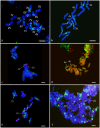Flow sorting and molecular cytogenetic identification of individual chromosomes of Dasypyrum villosum L. (H. villosa) by a single DNA probe
- PMID: 23185561
- PMCID: PMC3502404
- DOI: 10.1371/journal.pone.0050151
Flow sorting and molecular cytogenetic identification of individual chromosomes of Dasypyrum villosum L. (H. villosa) by a single DNA probe
Abstract
Dasypyrum villosum (L.) Candargy (sin. Haynaldia villosa) is an annual wild diploid grass species (2n = 2x = 14; genome VV) belonging to the Poaceae family, which is considered to be an important source of biotic and abiotic stress resistance genes for wheat breeding. Enhanced characterization of D. villosum chromosomes can facilitate exploitation of its gene pool and its use in wheat breeding programs. Here we present the cytogenetic identification of D. villosum chromosomes on slide by fluorescent in situ hybridization (FISH), with the GAA simple sequence repeat (SSR) as a probe. We also describe the isolation and the flow cytometric analysis of D. villosum chromosomes in suspension, resulting in a distinguished flow karyotype. Chromosomes were flow sorted into three fractions, according their DNA content, one of which was composed of a single type of chromosome, namely 6 V, sorted with over 85% purity. Chromosome 6 V is known to carry genes to code for important resistance and seed storage characteristics, and its isolation represents a new source of genetic traits and specific markers useful for wheat improvement.
Conflict of interest statement
Figures




Similar articles
-
Cytogenetics of Triticum x Dasypyrum hybrids and derived lines.Cytogenet Genome Res. 2005;109(1-3):385-92. doi: 10.1159/000082424. Cytogenet Genome Res. 2005. PMID: 15753601
-
Centromeric distribution of 350-family in Dasypyrum villosum and its application to identifying Dasypyrum chromatin in the wheat genome.Hereditas. 2009 May;146(2):58-66. doi: 10.1111/j.1601-5223.2009.02110.x. Hereditas. 2009. PMID: 19490166
-
Chromosome diversity in Dasypyrum villosum, an important genetic and trait resource for hexaploid wheat engineering.Ann Bot. 2023 Feb 7;131(1):185-198. doi: 10.1093/aob/mcac054. Ann Bot. 2023. PMID: 35451455 Free PMC article.
-
Introduction of chromosome segment carrying the seed storage protein genes from chromosome 1V of Dasypyrum villosum showed positive effect on bread-making quality of common wheat.Theor Appl Genet. 2014 Mar;127(3):523-33. doi: 10.1007/s00122-013-2244-0. Epub 2014 Jan 10. Theor Appl Genet. 2014. PMID: 24408374 Review.
-
Detection of alien chromatin introgression from Thinopyrum into wheat using S genomic DNA as a probe--a landmark approach for Thinopyrum genome research.Cytogenet Genome Res. 2005;109(1-3):350-9. doi: 10.1159/000082419. Cytogenet Genome Res. 2005. PMID: 15753596 Review.
Cited by
-
Flow cytometric characterisation of the complex polyploid genome of Saccharum officinarum and modern sugarcane cultivars.Sci Rep. 2019 Dec 18;9(1):19362. doi: 10.1038/s41598-019-55652-3. Sci Rep. 2019. PMID: 31852940 Free PMC article.
-
Laser Capture Microdissection: From Genomes to Chromosomes, from Complex Tissue to Single-Cell Analysis.Methods Mol Biol. 2023;2672:163-175. doi: 10.1007/978-1-0716-3226-0_9. Methods Mol Biol. 2023. PMID: 37335475
-
Molecular and Cytogenetic Characterization of New Wheat-Dasypyrum breviaristatum Derivatives with Post-Harvest Re-Growth Habit.Genes (Basel). 2015 Nov 27;6(4):1242-55. doi: 10.3390/genes6041242. Genes (Basel). 2015. PMID: 26633516 Free PMC article.
-
Chromosome analysis and sorting.Cytometry A. 2021 Apr;99(4):328-342. doi: 10.1002/cyto.a.24324. Epub 2021 Feb 21. Cytometry A. 2021. PMID: 33615737 Free PMC article. Review.
-
Flow sorting of C-genome chromosomes from wild relatives of wheat Aegilops markgrafii, Ae. triuncialis and Ae. cylindrica, and their molecular organization.Ann Bot. 2015 Aug;116(2):189-200. doi: 10.1093/aob/mcv073. Epub 2015 Jun 4. Ann Bot. 2015. PMID: 26043745 Free PMC article.
References
-
- Zamir D (2008) Plant breeders go back to nature. Nature Genetics 40: 269–270. - PubMed
-
- Feuillet C, Langridge P, Waugh R (2008) Cereal breeding takes a walk on the wild side. Trends in Genetics 24: 24–32. - PubMed
-
- Hajjar R, Hodgkin T (2007) The use of wild relatives in crop improvement: A survey of developments over the last 20 years. Euphytica 156: 1–13.
-
- Babu TEG, Mastan SA (2009) Transgenic technology and crop improvement – a review. Journal of Pure and Applied Microbiology 3: 311–318.
-
- Bhalla PL (2006) Genetic engineering of wheat – current challenges and opportunities. Trends in Biotechnology 24: 305–311. - PubMed
Publication types
MeSH terms
Substances
LinkOut - more resources
Full Text Sources
Miscellaneous

